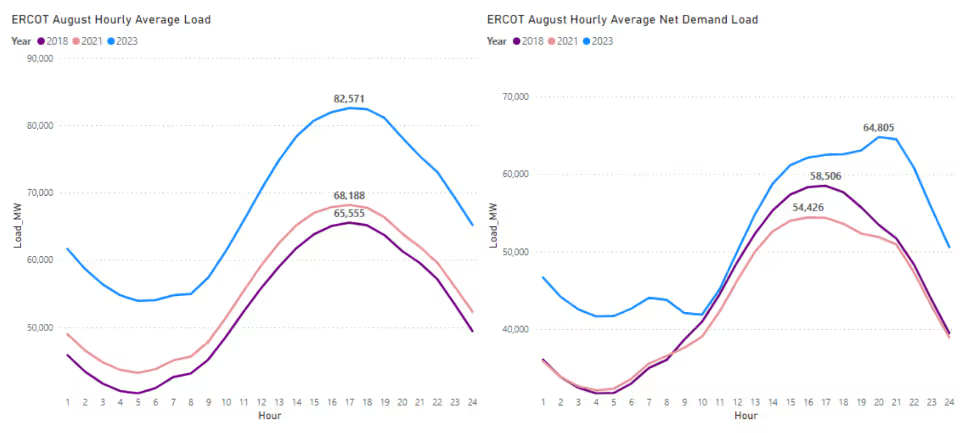
With ERCOT's unprecedented Summer of 2023 in the rear view, let’s look at some of the emerging trends and their profound implications for our load-serving entities.
ERCOT hit so many peak demand records that they unveiled a new webpage dedicated to Peak Demand Records. ERCOT set a staggering 10 new all-time peak demand records, culminating in a new all-time peak demand record of 85,464 MW on August 10, 2023.
In the face of these peak events on the ERCOT grid, the state of Texas is fortunately setting other records, as Texas now leads the U.S. in utility-scale solar, surpassing California.
With these colliding trends, we’re seeing ERCOT’s riskiest hour of a typical summer day shift later into the evening. One way to visualize this shift is by comparing the Net Load growth since 2018. Net Load is the total electricity demand minus renewable generation. By stripping out wind and solar, we can identify instances where demand is closing in on dispatchable supply, thus increasing the risk of potential load-shedding events.

The shift of the riskiest hour for energy demand from late afternoon to early evening has significant implications for load-serving entities operating in ERCOT. With the increasing prevalence of solar power generation during the daytime, late afternoon demand, traditionally a period of high risk for grid operators, has seen reduced vulnerability. However, as the sun sets and solar generation diminishes, the risk of energy emergencies escalates, particularly between 8 p.m. and 9 p.m. During this critical evening period, the capacity for operating reserves may dip below acceptable levels, presenting a daunting challenge for load-serving entities.
We sat down with Rayburn Electric Cooperative’s Director of Power Supply, Christian Nagel, for a Q&A to shed light on the implications of this trend.
–
Future Planning: What steps are you taking to adapt to this evolving scenario? Are there plans to invest in energy storage technologies, demand response programs, or grid enhancements to better manage the risk?
We are addressing the shift in these market fundamentals from multiple angles. We recently acquired a baseload combined-cycle facility and are exploring other flexible power-supply resources to adapt to changing net load patterns. Additionally, we've initiated a Distributed Energy Resources (DERs) program in collaboration with our distribution cooperatives to mitigate demand-side risks. Furthermore, our team, led by Rayburn and our Members, is actively addressing supply chain and regulatory challenges to expand our transmission and distribution infrastructure for enhanced resilience and growth.
Demand Response and Consumer Engagement: Are you engaging with consumers to reduce evening peak demand through demand response programs or other initiatives? How do consumers play a role in managing risk?
Our DER program strategically leverages assets to reduce demand during critical periods, such as the 4CP hours and net-load peak hours, where the pricing risk is most critical. As we expand the program, increasing resource diversity between commercial and industrial (C&I) and residential loads, it will enhance our flexibility in deploying these resources to mitigate both 4CP and net-load peaks. We've found that offering financial incentives is the most effective approach to encourage consumer engagement in helping us manage these risks.
Weather Variability: How does weather forecasting and monitoring play a role in your decision-making during the evening hours, especially regarding wind and solar output? How do you prepare for extreme weather events that can impact demand?
Due to the high penetration of renewables on the ERCOT grid, our load peaks are now less correlated with ERCOT pricing risks. The primary focus has shifted towards accurately forecasting system-wide wind and solar output, where the pricing risk lies. Rayburn's load is highly weather-sensitive due to the large number of residential members served by our distribution cooperatives. Amperon’s load forecasts are critical for planning our supply and demand response assets, especially during extreme weather events. In addition to its commercial implications, weather forecasting significantly impacts our transmission and distribution teams, all of which are dedicated to serving our members. They are well-prepared to maintain power supply and respond swiftly in the event of equipment failure during extreme conditions, aligning with our Member Focused and Member Driven approach.

.svg)
.svg)
.svg)
.svg)
